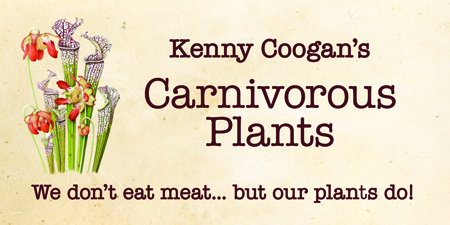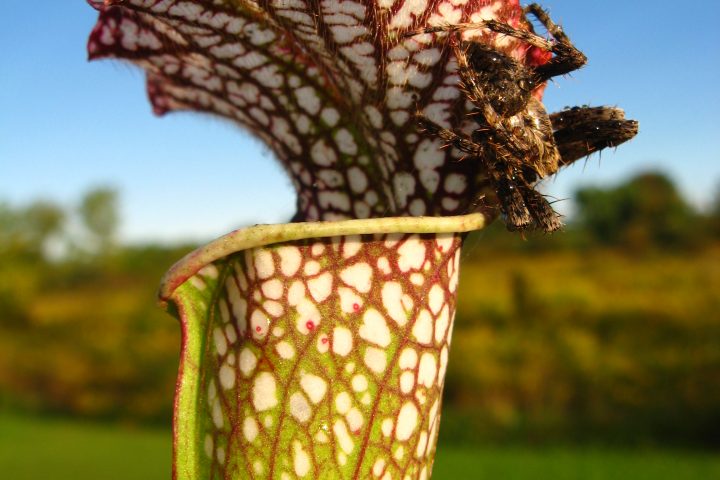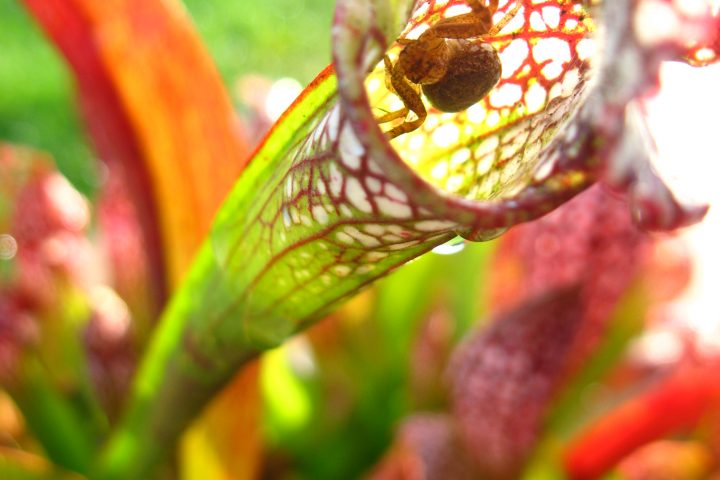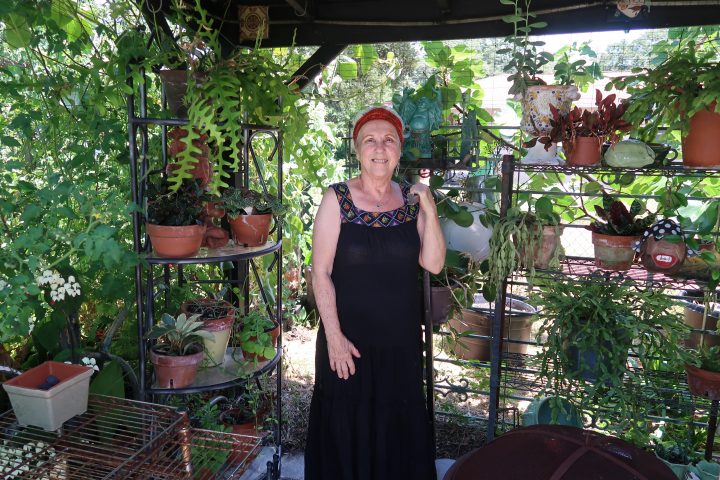It is time now to start the odd jobs of summer with indoor spring cleaning behind us. Composting is a year round essential aspect of gardening in Florida and is a perfect project to start today. Composting allows you to reduce your mainstream waste flow and helps enrich your soil, which is incredibly important for those of us who garden on this sand based state.
Free is For Me
Out of all the different compost units I have on my property, the one the works best was free and built out of pallets. Although there is no standard sizes for pallets, a total of nine free pallets, found at numerous feed and grocery stores, will allow you to create a large enough structure to handle even the largest family’s compost materials. Many pallets that can be found at grocery stores are 40 inch squares.
With your nine free pallets, build three cubes, side by side with open tops and bottoms. Having the bottom touching the ground will allow beneficial detritus feeders (including those all-purpose earthworms) easy access to start their decomposing jobs.
Cubes that are adjacent to one another will share a pallet as a side wall. For the front of your three compost cubes, you can cut your ninth pallet in thirds. Using one third for each of the cubes’ fronts will allow easy access for turning the piles yet prevent compost from falling out.
Each cube will serve a different function in the cycle of composting. The first bin will be for storing new material, the second for cooking the material, and the third for storing the finished compost. The reason why I use this the three bin method is because it is almost self-sufficient compared to those small store models which do not produce enough heat, unless there is daily attention given. I was once told by Steve Allgeier the Home Horticulture Consultant and Master Gardener Coordinator for the University of Maryland Extension office that the three bin system is, “The Cadillac of composting.”
The best location for the three bin compost system is an easily accessible one. If it is out of sight, out of mind, and out of use, then you are not composting. My property, which is a little larger than one acre, has a lot of shade. Having hot compost bins is ideal, as it helps break down the organic matter quicker, which in turn will be able to be added to your gardens sooner. Due to the shade, I have my edible gardens scattered amongst the sunny patches of my property. At each garden, I have a composting system. Although these bins are away from my kitchen and backdoor, once the compost is ready, it is easy to apply the “black gold.” One of my gardens has a banana tree growing about six feet away from a bin. The tree grows with the most vigor and is one of the first to produce seasonally! The banana tree most likely has a few roots under the compost bin. Convenience is key when it comes to compost placement – even my edibles agree.
The workings
The microorganisms which can be found in the soil, on plants, or in nature break down the chunky material to a mature compost which can be used as a slow-release food source for plants. In addition to changing the chemical structure and adding nutrients, compost improves a soil’s physical structure making it easier to till. Compost can improve the chemical structures that buffers the potential harmful effects of salts, especially important for those living near the coast. Compost improves the water holding capacity in the soil, for which Sunshine State gardeners truly enjoy about nine months of the year.
Composting accelerates the natural process of decomposition. Yard and kitchen waste get turned into hummus through composting, which can be turned into the soil. Working with the natural organisms and allowing sufficient air and water into the system, you can speed up the natural process of decomposition.
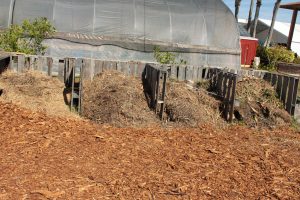
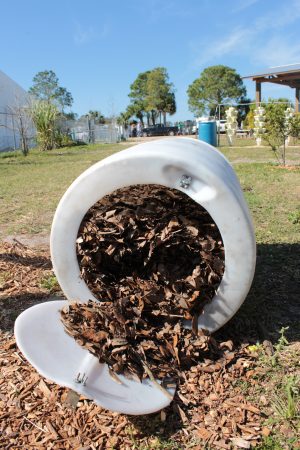
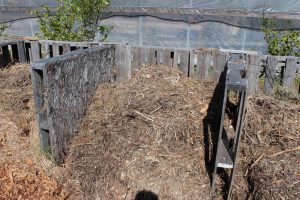
As you collect yard and kitchen scraps daily or weekly place them in the first bin. When you are ready to accelerate the compost process, place them in the middle cube, adding supplemental moisture. Using a pitch fork, turn the material in this bin weekly during the warm season and monthly during the winter.
According to the University of Florida, “Rapid composting requires an environment in which microorganisms will thrive. To compost well, you must “think like a microbe” and create the best environment to support microbial activity.” On average you will want: 30:1 carbon to nitrogen ratio, 40-60% moisture, adequate depth of material to help generate microbial heat (140°-160°), and weekly turning of the material for aeration. Here are a few ideas of what you can add to your pile.
| Carbon
(20-30 parts) |
Nitrogen
(1 part) |
| “Brown,” dry materials | “Green,” wet materials |
| Bedding | Garden waste |
| Leaves | Lawn clippings |
| Newspaper | Weeds |
| Sawdust | Poultry manure |
| Shredded cardboard | Coffee grounds |
| Straw & spoiled hay | Kitchen scraps |
When internal compost temperatures drop under 130°, eggs and cysts of flies and parasites will start to increase. Temperatures over 160° do not promote organisms that actively help with decomposition. “Compost pile temperature is a function of the biological activity within the composting system, and, to some extent, its exposure to the sun,” the University of Florida Sarasota IFAS says. “When microbes flourish, they will raise the pile temperature through their metabolism, reproduction, and conversion of composting materials to energy.” Compost thermometers can be found at most extension offices or home improvement store.
Troubleshooting
If you currently compost or have so in the past unsuccessfully check out this troubleshooting guide.
| Composting Troubles | |
| Symptoms | Solutions |
| Bad odor | Add carbon such as leaves, woodchips, cornstalks, soy-based newsprint/Spam mail. |
| Compost is moist and hot only in the center | Too small: add more materials, like above. |
| Excessive amount of flies | Aerate pile to burry kitchen wastes. Insect life is a sign of a productive compost. |
| Large pieces not decomposing | Pile may be too small. Remove items and cut or shred before adding. |
| Not hot enough | Too small: add volume to increase the size of the pile, water to promote organisms, nitrogen for them to feed on and air to start the aerobic breakdown OR compost may be finished. |
| Pile is warmer than 160° | Not enough air and carbon. Rotate pile and mix in carbons. |
| Vermin | Remove fat items such as meat, animal bi-products. |
Heap, Heap, Hooray
Your finished compost heap will be rich brown, flaky, and smell earthy. It will resemble the bags sold in garden centers labeled as potting mix. Using your thermometer as a backup, the hot temperature will indicate your composts readiness to be added into beds. In addition to being used for fruit and vegetable gardens, compost can be used anywhere you want to plant – ornamentals, roses, even house plants.
Composting promotes healthy soil life and organisms, increases water and nutrient retention. With no money, a little time and energy you can start composting today and you and your garden will reap the benefits tomorrow.
To learn more about homesteading and making compost, check out my newest book: 99½ Homesteading Poems
